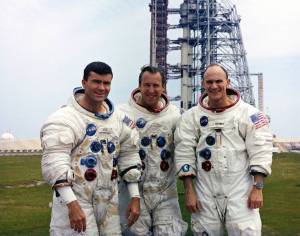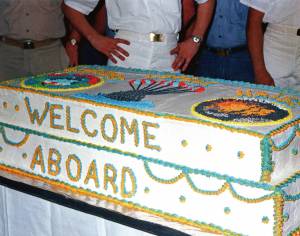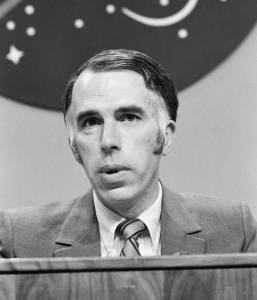The crew of Apollo 13, Commander James A. Lovell, Command Module Pilot (CMP) John L. “Jack” Swigert and Lunar Module Pilot (LMP) Fred W. Haise, still 175,000 miles from Earth, looked back at the Moon and realized that according to the normal flight plan, Lovell and Haise would have just landed their Lunar Module (LM) Aquarius in the Fra Mauro highlands as Swigert orbited the Moon in the Command Module (CM) Odyssey. Of course, those plans changed a little over two days before when an explosion rocked their spacecraft, depriving Odyssey of power and oxygen. All three took refuge in Aquarius and, abandoning Moon landing plans, looped around the Moon, using the LM’s engine to speed their return to Earth instead of landing them on the lunar surface. In Mission Control at the Manned Spacecraft Center, now the Johnson Space Center in Houston, teams of flight controllers worked around the clock to ensure the astronauts returned safely. Lead Flight Director Milton L. Windler and his Maroon Team as well as Capcom Jack R. Lousma had just resumed their positions in Mission Control to begin their next shift in support of Apollo 13. Approximately 36 hours remained until splashdown.
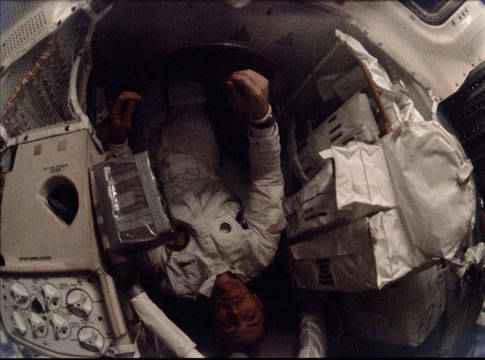
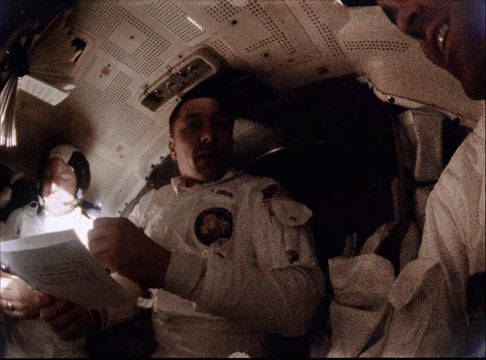
Left: Swigert entering the LM Aquarius through the docking tunnel. Right: Haise in the LM Aquarius making notes on a checklist.
Although Mission Control wanted Swigert and Haise to get some sleep while Lovell kept watch, all three crewmembers stayed awake and continued working. Lousma informed them that the status of all their consumables appeared sufficient to last the remainder of the mission, some with very comfortable margins, with the partial powerdown of Aquarius contributing significantly to power and cooling water margins. Eventually, Haise went to sleep in the tunnel between the two spacecraft with his head resting on the LM’s ascent engine cover and Swigert on the floor of the LM. While Lovell kept watch, Lousma walked him through the planning activities ongoing in Mission Control, including a possible final midcourse correction about five hours before entry, the charging of two of Odyssey’s three batteries from Aquarius, a procedure never done before but essentially just reversing one in which the CM supplies power to the LM on its initial activation, reactivating the CM and the sequence for jettisoning first the Service Module (SM) and finally the LM just prior to reentry.
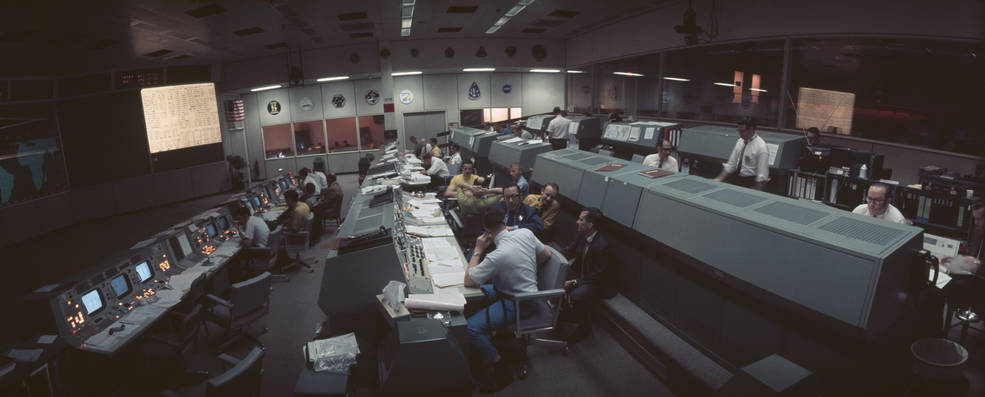
Mission Control on the day before splashdown.
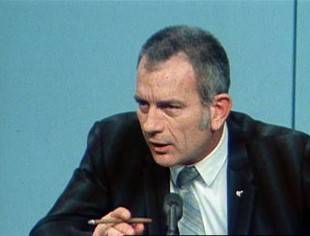
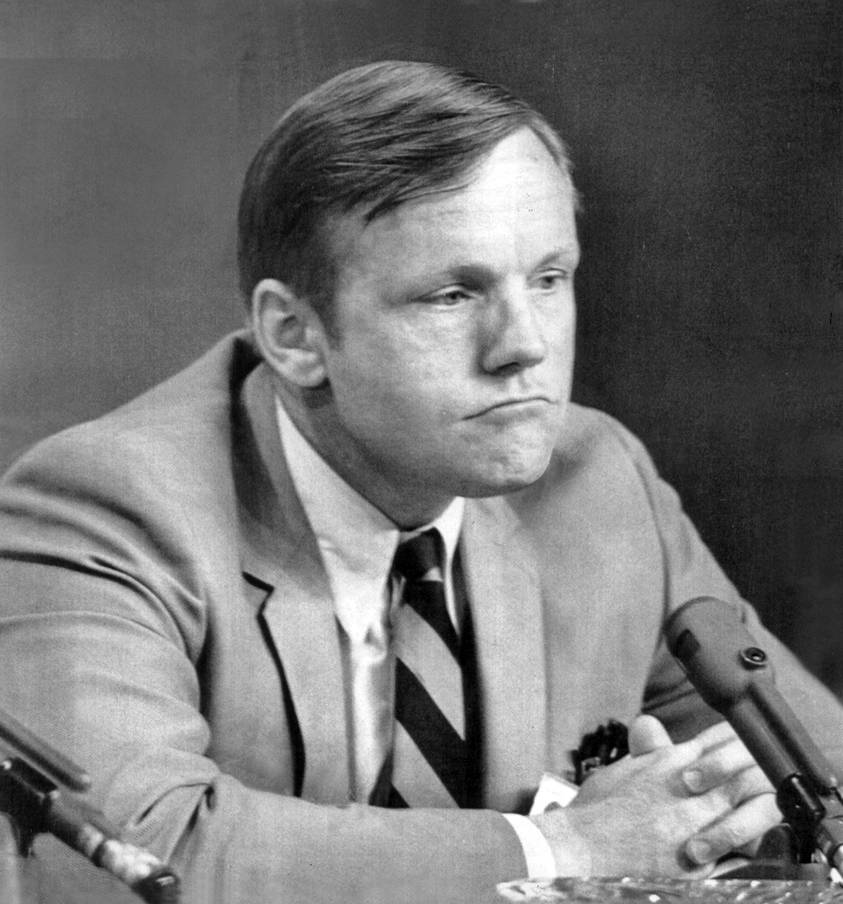
Left: Slayton during a press conference on flight day 5. Right: Armstrong during his flight day 5 press conference.
Shortly after the astronauts began the 15-hour recharge of Odyssey’s batteries, Flight Director Glynn S. Lunney and his Black Team of controllers relieved Windler’s team and Joseph P. Kerwin replaced Lousma as Capcom. Swigert and Haise ended their short sleep periods and Lovell took a turn at resting, but was back up within two hours. Due to cold cabin temperatures, about 51°F in Aquarius and in the 40s in Odyssey, Lovell reported to Kerwin that he and Haise used the lunar surface overshoes to keep their feet warm and donned two pairs of underwear. Back in Houston, Chief of Flight Crew Operations Donald K. “Deke” Slayton and Apollo 11 Commander Neil A. Armstrong gave separate press conferences to update the media on the flight of Apollo 13.
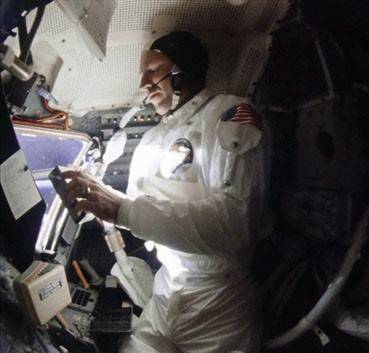
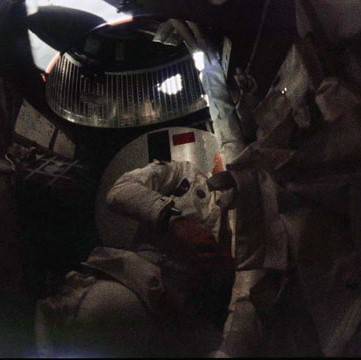
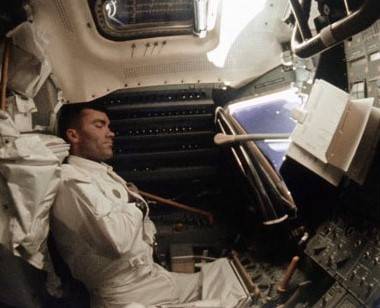
Left: Lovell in the LM Aquarius. Middle: Swigert sleeping in the LM Aquarius. Right: Haise sleeping in the LM Aquarius.
With all three crewmembers awake, Kerwin read up to them the overall flow of events for last six and a half hours of their mission, beginning with activating and warming up the CM’s Reaction Control System (RCS) thrusters followed by activating the LM’s systems to prepare for the final midcourse correction maneuver using the LM’s RCS thrusters. From that position, they would jettison the SM and try to obtain some photographs that might show the damage from the oxygen tank explosion. About two hours prior to entry, they would reactivate the CM which had been in a dormant state for four days, one hour later jettison the LM and begin preparations for reentry into the Earth’s atmosphere. After that long conversation, the Gold Team of Flight Director Gerald D. “Gerry” Griffin relieved Lunney’s engineers and Vance D. Brand relieved Kerwin at the Capcom console. Brand’s first order of business was to send up to the crew the CM stowage plan including which items to transfer to the LM and what things to bring in from the LM prior to separation, including the astronauts themselves! Proper stowage was essential because mass distribution affected the aerodynamic performance of the CM.
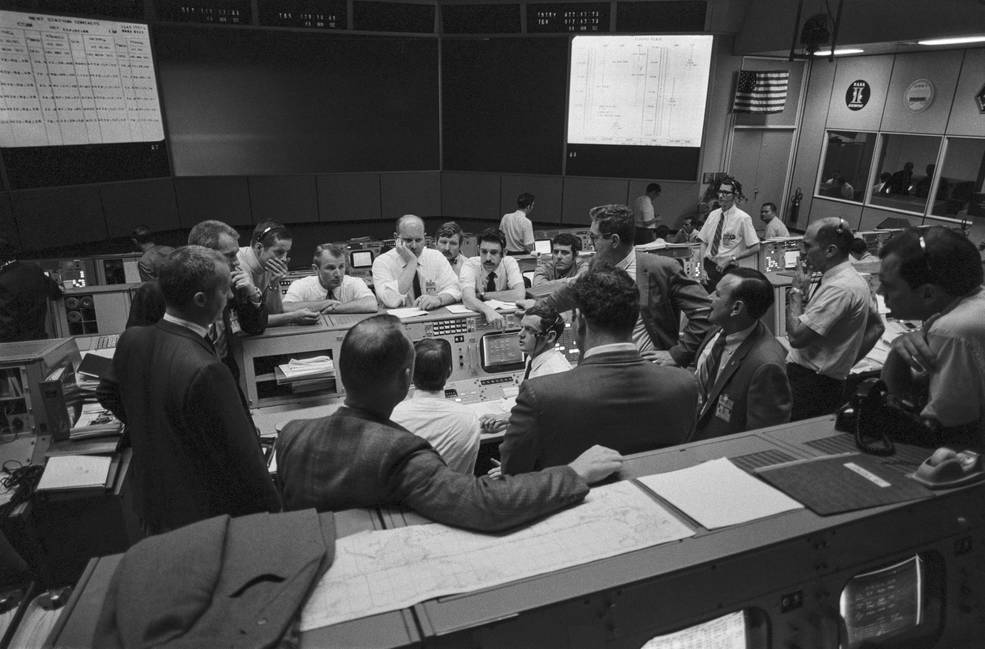

Left: An impromptu meeting around the Flight Director’s console to discuss reentry procedures. Right: Lovell (left) and Swigert reviewing the entry checklist.
When it was time to read up the complex new procedures to reactivate the CM and separate the SM, astronaut Thomas K. “Ken” Mattingly took over the Capcom duties. Mattingly, the original Apollo 13 CMP grounded two days before launch due to concerns over his exposure to German measles, had spent hours in the CM simulator finalizing the procedures. A coded exchange between Lovell and Brand (Lovell: “Are the flowers in bloom in Houston?”, Brand: “No, not yet. Still must be winter.”) confirmed that Mattingly did not contract the infectious disease and had put his talents to work to help recover his fellow astronauts. Brand then read up the procedure for the LM deactivation and jettison to Haise. Aboard Apollo 13, now 86,000 miles from Earth and continuing to accelerate, Lovell and Swigert tried to get some sleep while Haise took the watch, while in Mission Control Lousma relieved Brand at the Capcom console and avoided calls to the crew to allow Haise to rest as well. The increasingly cold temperatures made sleep difficult, and Haise began to experience chills, the first symptoms of his developing urinary tract infection likely caused by dehydration. To help warm the spacecraft and make the crew more comfortable, Mission Control gave the GO to activate the LM three hours early and orient it so it received more sunlight through its windows. Flight Director Eugene F. “Gene” Kranz and his White Team of controllers took their consoles about eight hours before entry, relieving Griffin’s team, and planned to monitor the mission all the way to splashdown. Kerwin replaced Lousma at the Capcom position for the last hours of the mission.
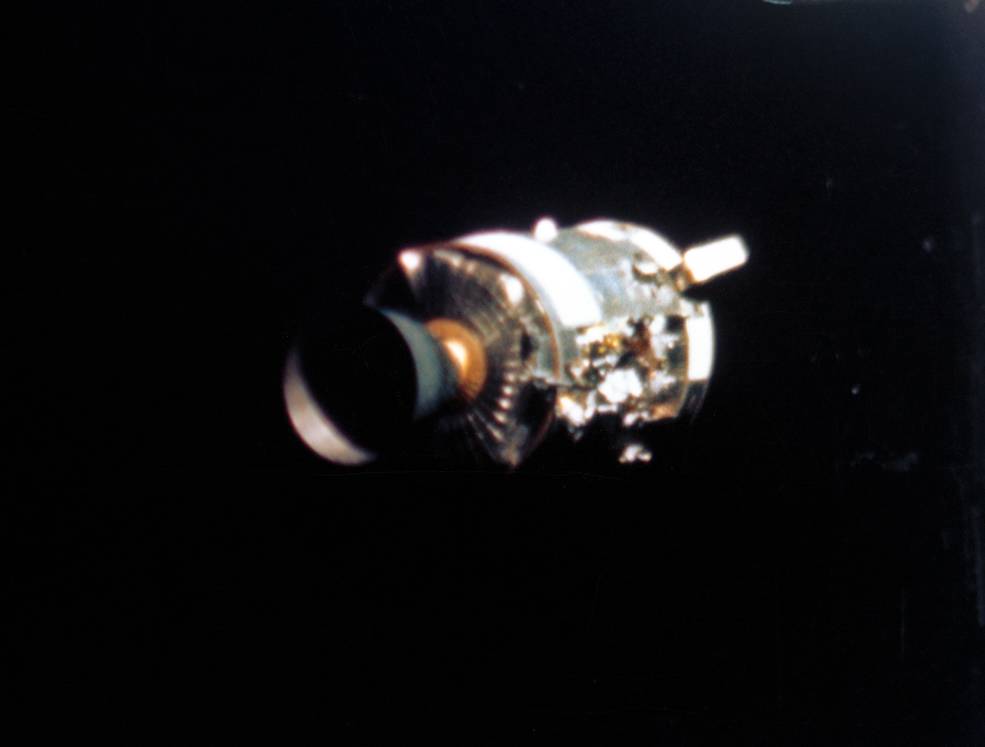
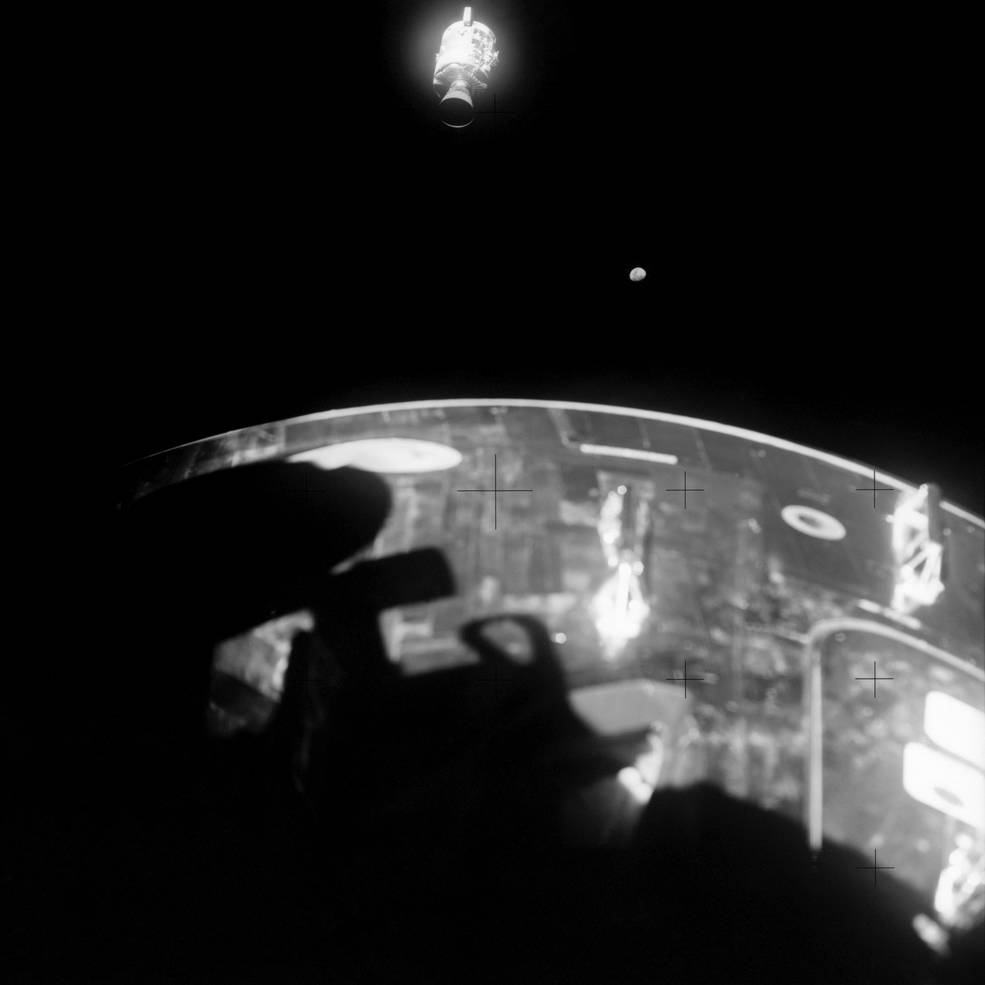
Left: View of the damaged SM shortly after the crew jettisoned it. Right: View of the departing SM, with the CM in the foreground and the Moon in the far distance.
With about six and a half hours to go in the flight of Apollo 13, Swigert entered Odyssey to begin the reactivation process. Using the LM’s navigation system, Lovell began the process of aligning the docked spacecraft to perform the final mid-course maneuver of the mission to fine tune the angle at which Apollo 13 entered the Earth’s atmosphere. Five hours before entry and at a distance of 44,000 miles from Earth, the astronauts fired the LM’s RCS thrusters for 23 seconds. Within one minute after the end of the successful burn, Lovell reoriented the spacecraft to prepare to jettison the SM that occurred 20 minutes later, at a distance of 41,049 miles from Earth. About two minutes later, the astronauts got their first view of the damaged SM, with Lovell exclaiming, “There’s one whole side of that spacecraft missing. Right by the high gain antenna, the whole panel is blown out, almost from the base to the engine.” Haise concurred, “It’s really a mess.”
Swigert continued activating Odyssey’s systems, some running from one the CM’s batteries with others still drawing power from Aquarius. At two and a half hours before entry, Mission Control gave Swigert the GO to activate all the CM’s systems from the batteries as Haise terminated the power transfer from the LM. He then joined Swigert in Odyssey to assist with the activation. With direct communications reestablished with Odyssey, Mission Control updated the spacecraft’s onboard computer and began monitoring its systems via telemetry, showing a cabin temperature of 38o F!
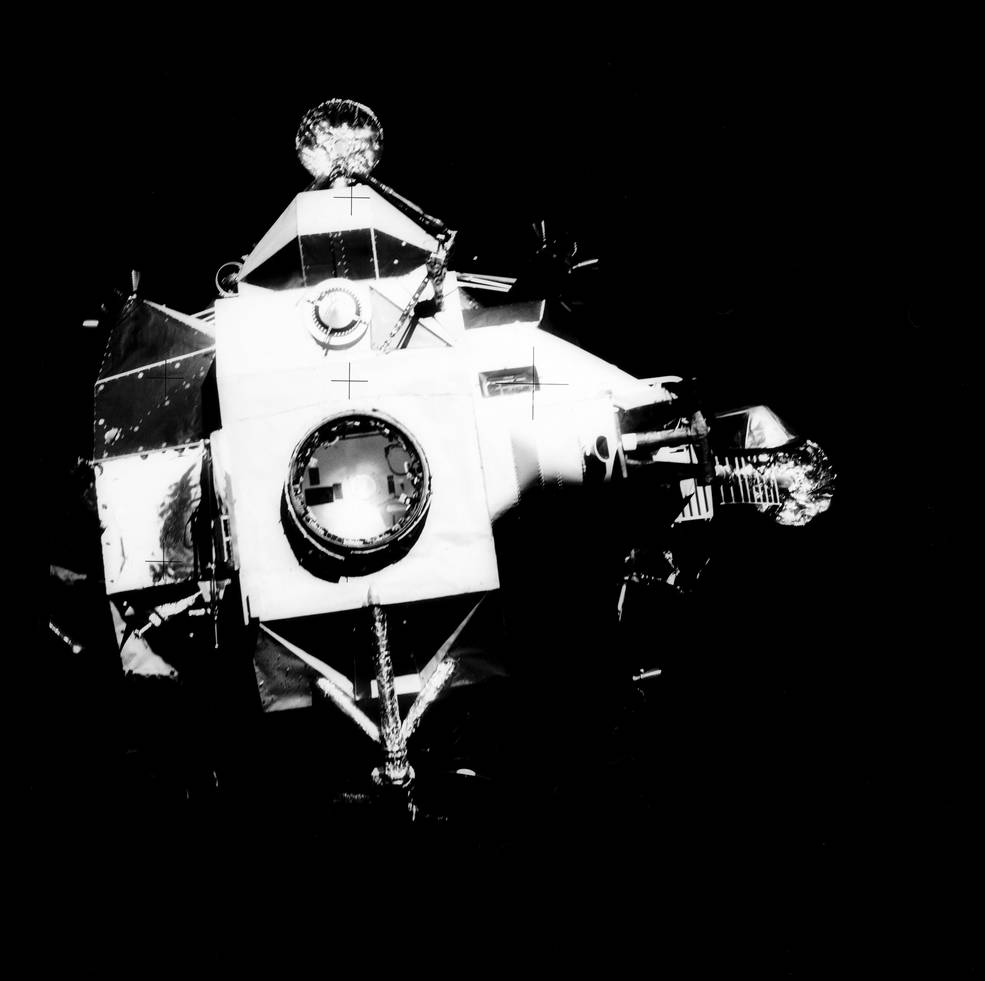
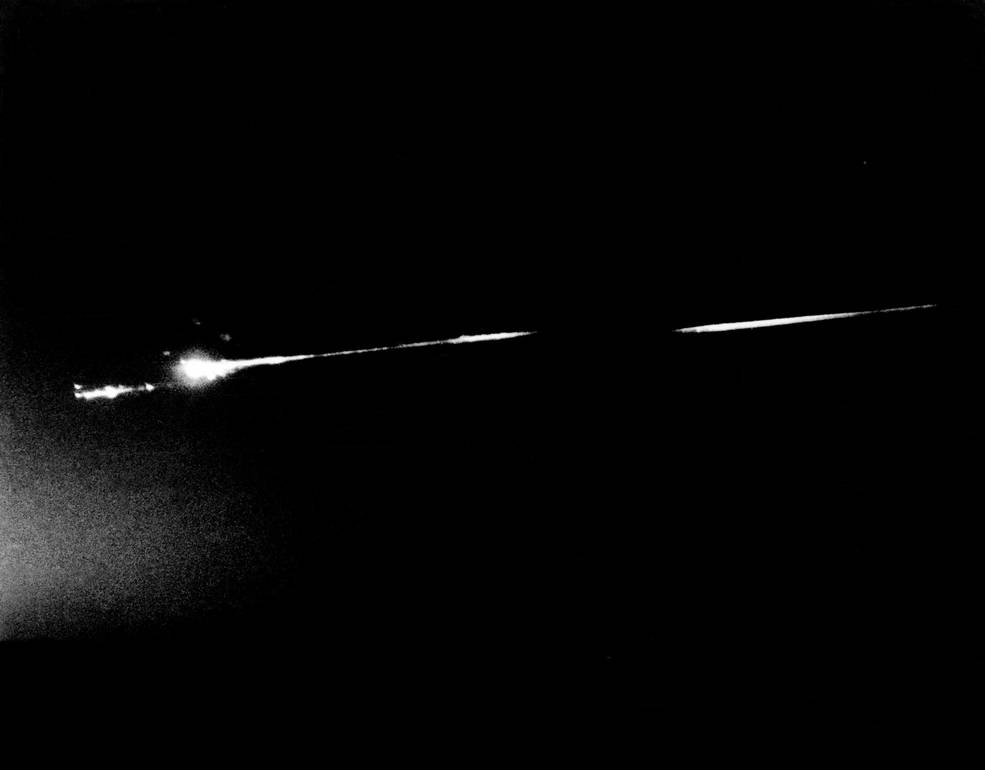
Left: View of the departing LM Aquarius shortly after the crew jettisoned it. Right: Photograph taken by an unidentified airline passenger of the LM and SM burning up on reentry.
The next task for the astronauts was the jettison of the LM Aquarius, the lifeboat that kept them safe for four days after the accident. Lovell essentially put Aquarius on autopilot, joined Swigert and Haise in Odyssey and closed the LM and CM hatches behind him. They partially depressurized the vestibule between the two spacecraft, using the remaining pressure as a propulsive force to send the LM on its way. At 141 hours and 30 minutes into the flight and at an altitude of 12,946 miles, they jettisoned the LM, prompting Capcom Kerwin to say, “Farewell, Aquarius, and we thank you.” Both the SM and LM burned up on reentry, and an unidentified passenger aboard an Air New Zealand airliner en route from Fiji to Auckland captured an image of them streaking across the night sky. Apollo 13 was now down to its final component, the CM Odyssey. The spacecraft continued to accelerate as it approached the Earth, and about an hour after saying farewell to the LM, it encountered the top layers of the planet’s atmosphere, having reached a top velocity of 24,689 miles per hour. The contact with molecules in the upper atmosphere at such high speed caused them to be ionized, cutting off communications with the spacecraft for several minutes, a period known as the blackout. The rapid deceleration resulted in the astronauts experiencing a peak load of about 5.2 gs.
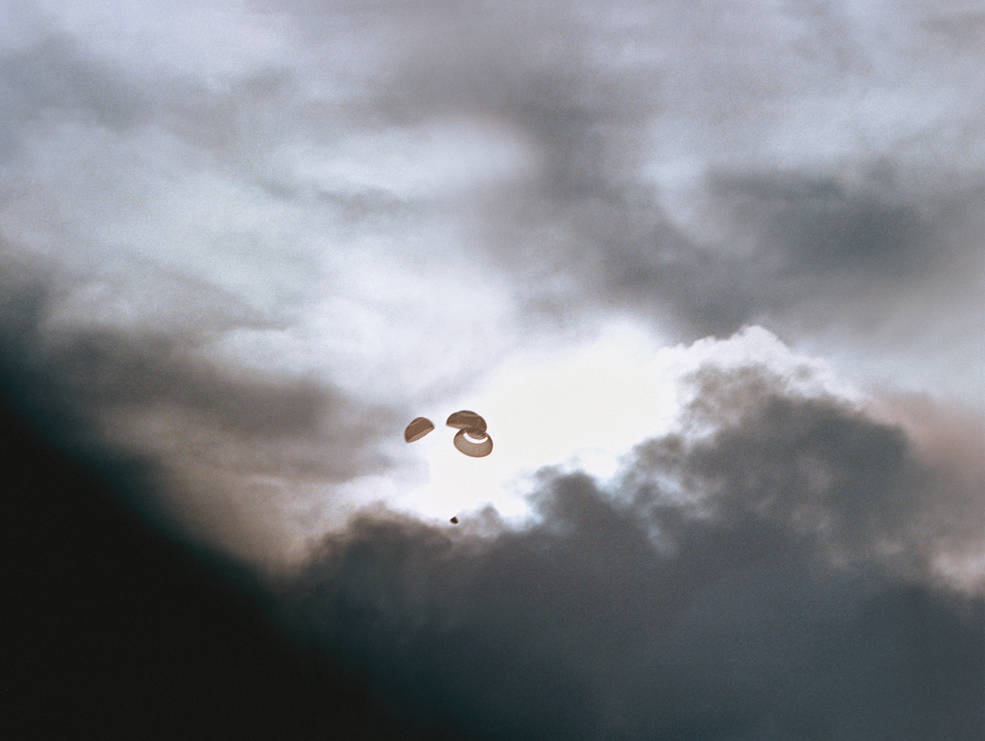
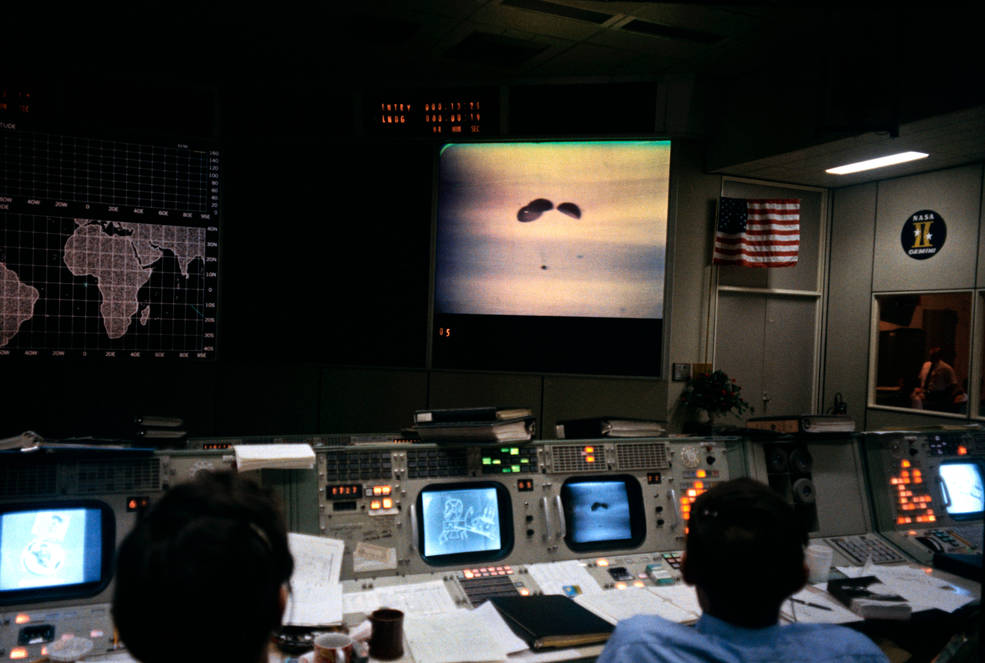
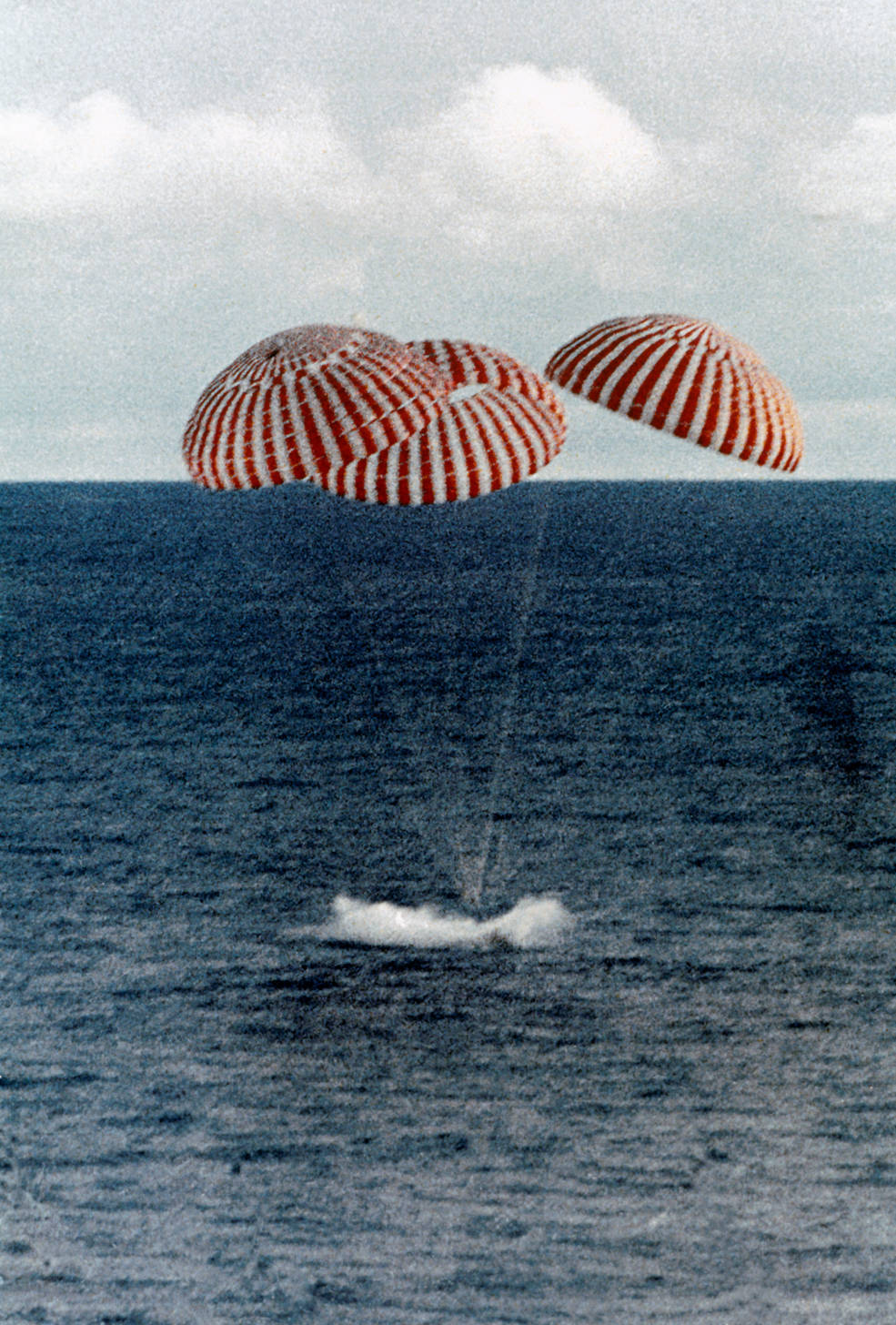
Left: Apollo 13 descending under parachutes. Middle: Controllers in Mission Control watching the descent of Apollo 13. Right: Moment Apollo 13 splashed down in the Pacific Ocean.
Coming out of the blackout, communications between Odyssey and Mission Control were restored. At an altitude of 24,000 feet, two drogue parachutes deployed to slow and stabilize the descending craft. At 10,000 feet the three main orange-and-white parachutes opened to gently guide Odyssey to the Pacific waters, with splashdown occurring after a flight of 142 hours 54 minutes and 41 seconds. The splashdown point was about one mile from the predicted target and four miles from prime recovery ship the USS Iwo Jima (LPH-2). The crew of Apollo 13 had made it back to Earth safely. In Mission Control, pandemonium erupted as the exhausted flight controllers, joined by astronauts, managers and VIPs, rejoiced in the successful conclusion of a very perilous mission.
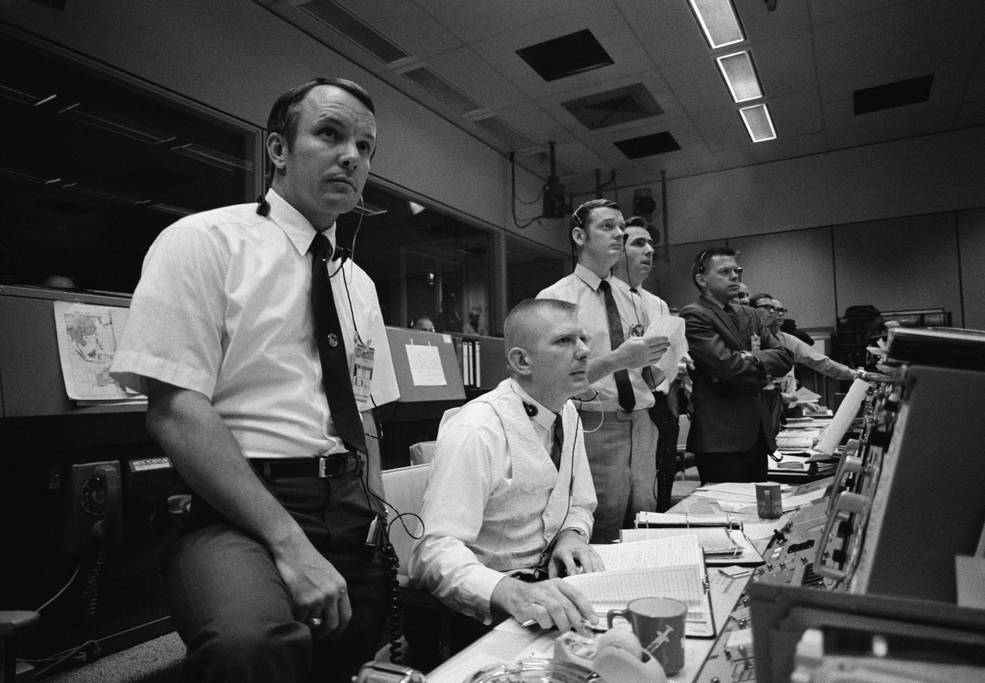
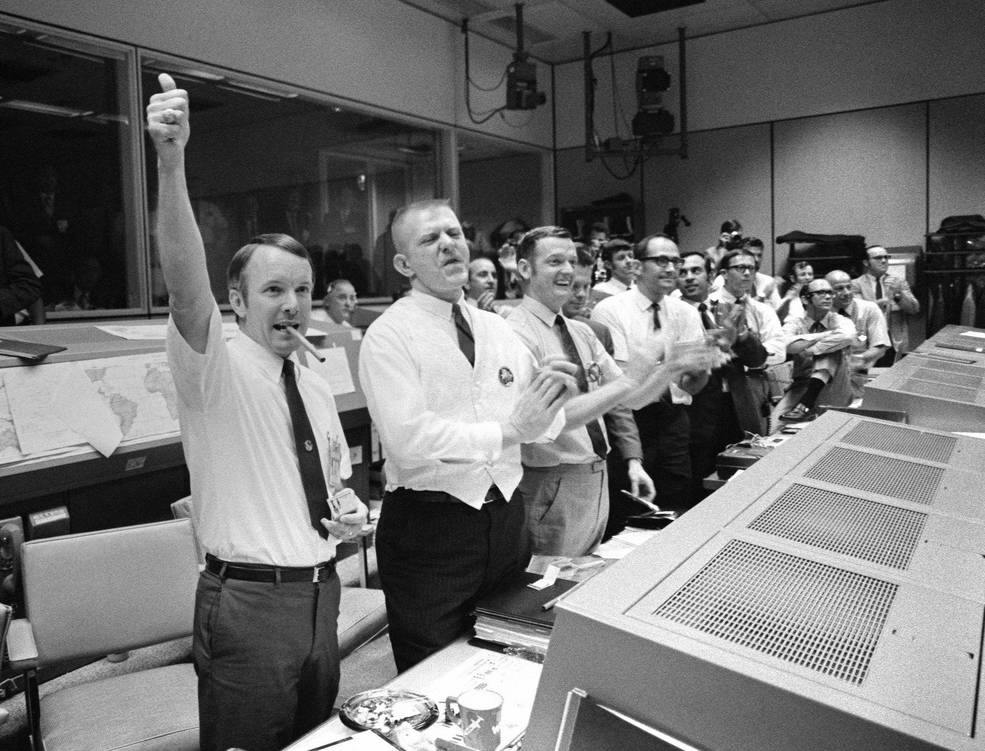
Left: Flight Directors (left to right) Griffin, Kranz, Lunney and Windler anxiously monitoring the return of Apollo 13. Right: Flight Directors (left to right) Griffin, Kranz, Lunney and Windler cheering after the successful splashdown of Apollo 13.
The recovery team of US Navy Frogmen and sailors from the USS Iwo Jima recovered the astronauts and delivered them by helicopter to the deck of the carrier. The Iwo Jima’s skipper, Captain Leland E. Kirkemo and Rear Admiral Donald C. Davis, Commanding Officer of Task Force 130 the Pacific Recovery Forces, welcomed them aboard the ship. After a brief welcoming ceremony, the astronauts were taken to the ship’s sick bay for a brief medical checkup and telephone conversations with their families. President Richard M. Nixon telephoned to congratulate them on their successful recovery. About an hour later, the sailors brought Odyssey aboard the ship. The Apollo 13 postflight activities differed from those of the previous two Apollo missions in that the crew did not enter quarantine since they didn’t land on the Moon, although all the pertinent facilities and personnel were deployed on the Iwo Jima.
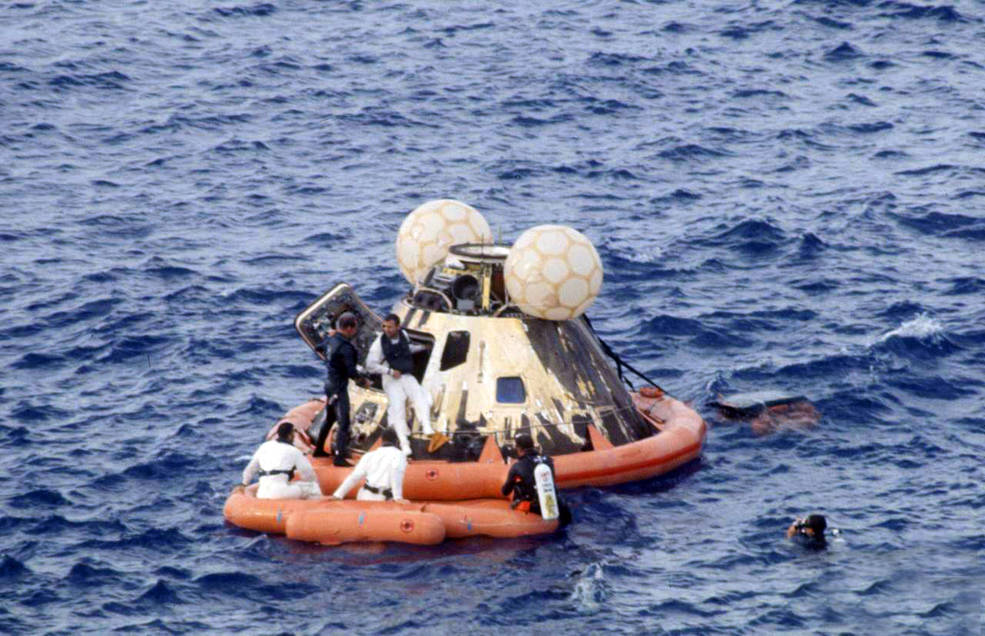
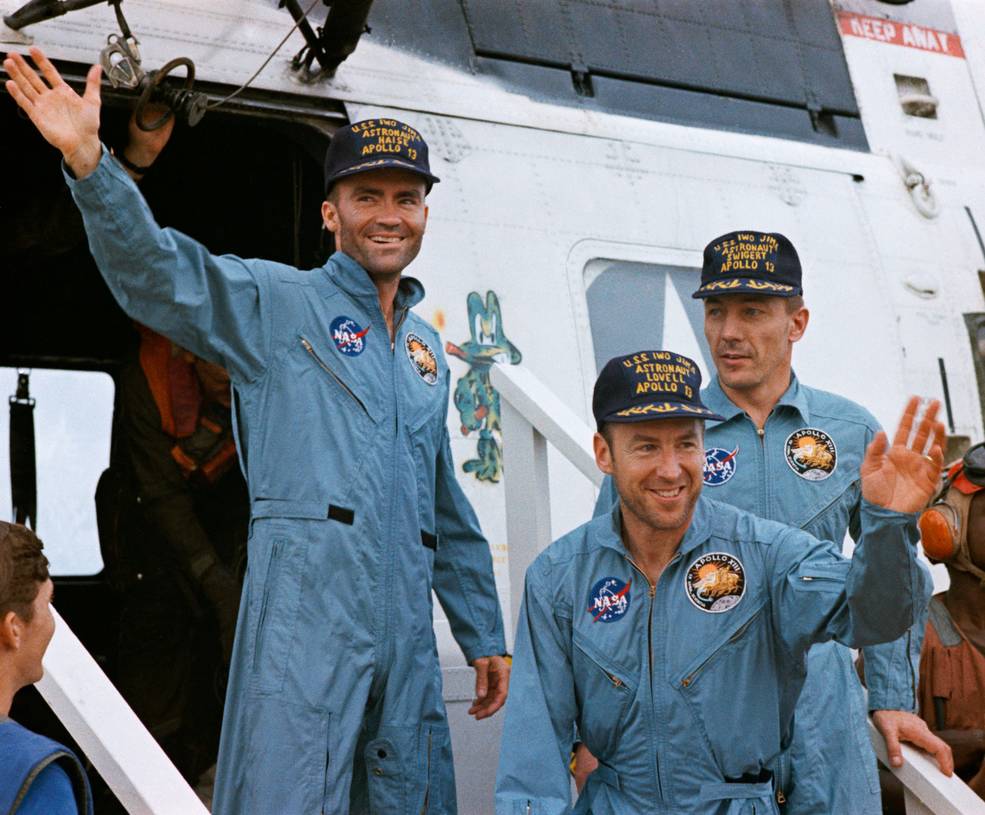
Left: Apollo 13 astronaut Lovell has just emerged from the CM as Haise (left) and Swigert watch from the recovery raft minutes after splashdown. Right: Apollo 13 astronauts (left to right) Haise, Lovell and Swigert wave to sailors after exiting the recovery helicopter on the USS Iwo Jima.
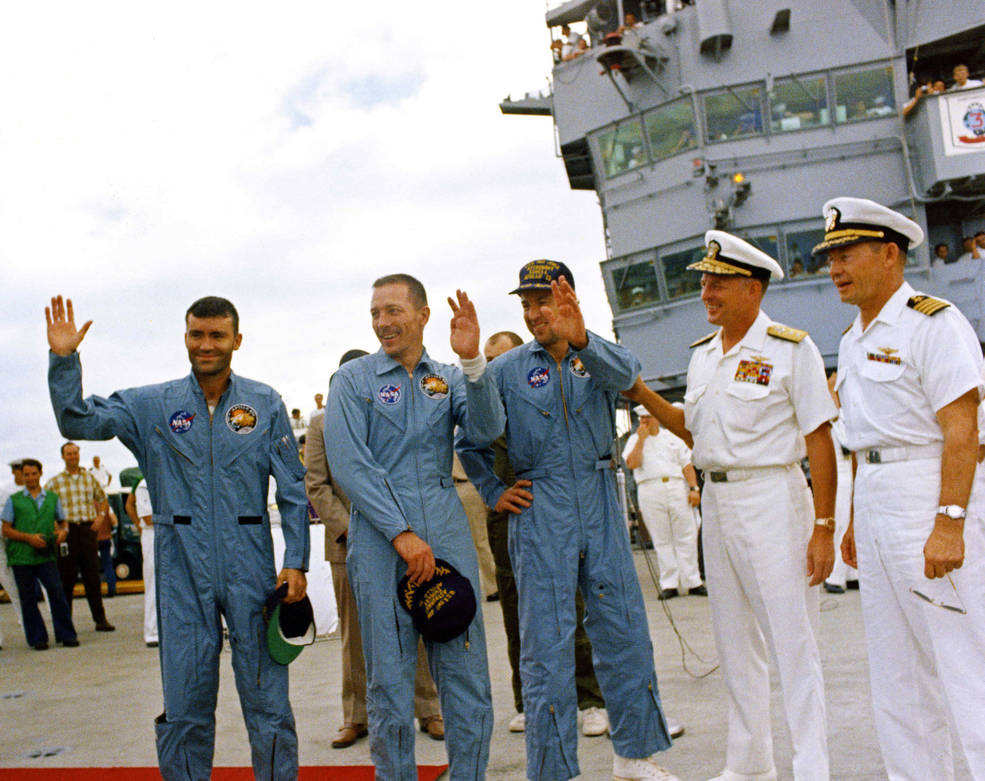
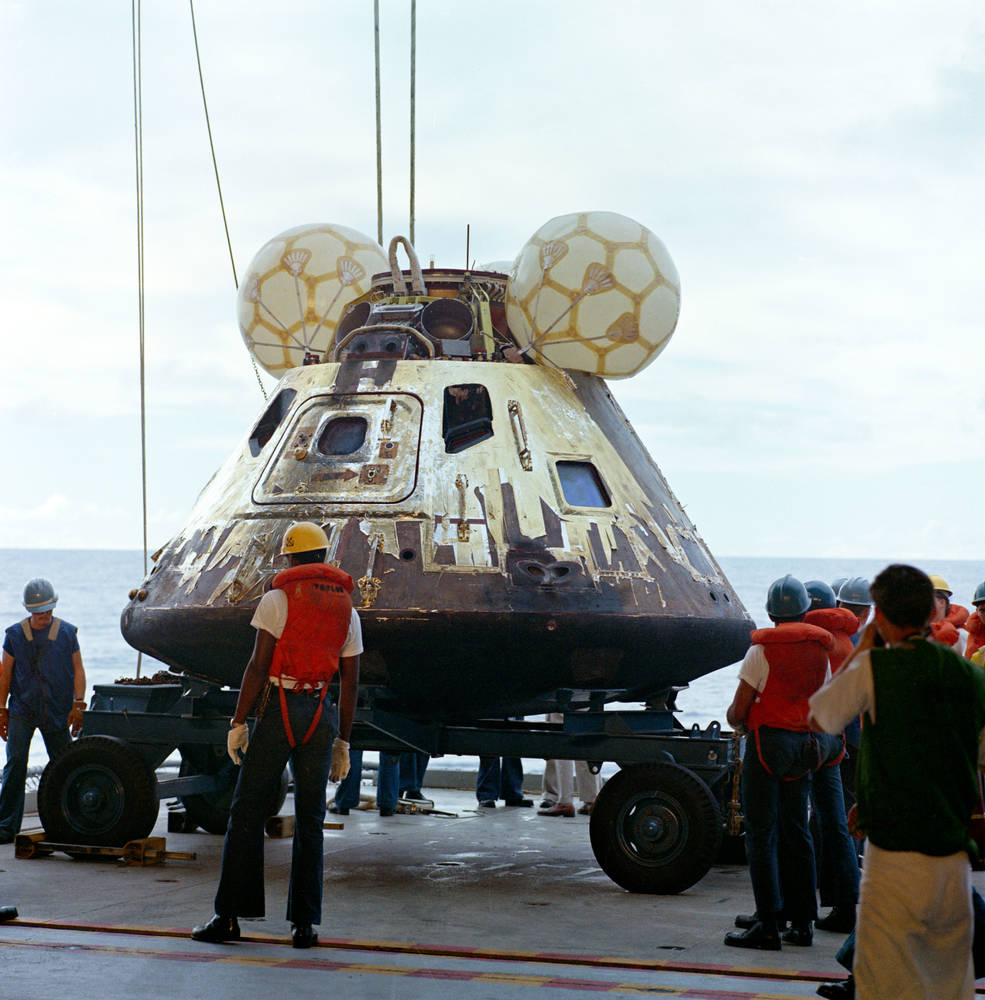
Left: Apollo 13 astronauts (left to right) Haise, Swigert and Lovell welcomed aboard the USS Iwo Jima by Admiral Davis and Captain Kirkemo (far right). Right: Sailors placing the Apollo 13 CM on the deck of the USS Iwo Jima.
Footnote: In Ron Howard’s film Apollo 13, Lovell wearing his old US Navy captain’s uniform makes a brief appearance playing the part of Capt. Kirkemo.
To be continued…



























